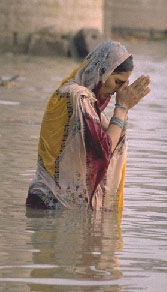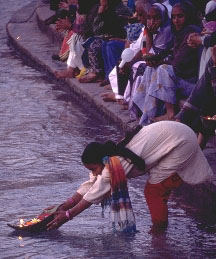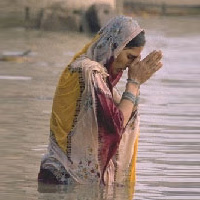India Spiritual Heritage – By Glen P. Kezwer, Ph. D.
 Spirituality is an intrinsic part of Indian culture and life. Every Indian home is adorned with a poojaa shrine containing a picture of Lord Krishna, Shri Ganesh, Lord Shiv, the Goddess Lakshmi, Saraswati, or some other deity surrounded by candles and incense and garlanded with a maalaa. It is here that people stop for a praanaam to the devi or devtaa, or to ring a bell and sit with eyes closed and hands folded for a few minutes every day. For the worshipper, this aspect of Indian culture serves as a constant reminder that behind the material forms which constitute our daily world, there is an unchanging consciousness which permeates everything.
Spirituality is an intrinsic part of Indian culture and life. Every Indian home is adorned with a poojaa shrine containing a picture of Lord Krishna, Shri Ganesh, Lord Shiv, the Goddess Lakshmi, Saraswati, or some other deity surrounded by candles and incense and garlanded with a maalaa. It is here that people stop for a praanaam to the devi or devtaa, or to ring a bell and sit with eyes closed and hands folded for a few minutes every day. For the worshipper, this aspect of Indian culture serves as a constant reminder that behind the material forms which constitute our daily world, there is an unchanging consciousness which permeates everything.
I myself am not of Indian origin. I was born and raised in Canada, but have spent the greater part of the past twenty years living in India. During this time India has become my home. I have traveled her highways and byways from Kerala and Tamil Nadu to Kashmir and Himachal Pradesh. I have traversed this vast land on her railways, buses, taxis and airplanes, as well as her elephants, camels and bullock carts. I have walked the streets of her cities, towns and villages, wandered her fields, climbed her mountains and roamed her forests. I have visited her temples, colleges, universities, cultural institutions, government offices and the homes of countless numbers of her citizens. I have met her politicians, professors, military personnel, business people, housewives, doctors, lawyers, wandering sadhus, coolies, temple poojaries, farmers,pandits, journalists and police officers. I have eaten her food, and been nourished by her wholesome dal, subji and roti. I have experienced the heartfelt hospitality of her people, being welcomed and treated as the Godly guest in the most humble of mud houses and the most magnificent of grand mansions. I have sat in meditation in her majestic temples, lectured in her institutions and universities, and waited in line in her banks, train stations, government offices and petrol stations. I have felt the warmth of her sunshine, been refreshed by her rain and breathed the air of this great and enchanting nation year after year.
My experiences in India have been many and diverse. I have been awed by the beauty of the dawning of a new year in a farmer’s field south of Delhi. I have been warmed by the first rays of the sun as I sat in a crowded motor rickshaw on a cold winter’s morning in Farrukhabad. I have sat on a rough bench in a beautiful garden in Bhind and been dazzled by the heartfelt tales of a venerable freedom-fighter. I watched the delighted look on the faces of Gandhian workers as I spoke of meditation and highest awareness at the Mahatma’s ashram in Wardha. I have had similar experiences when speaking to the senior officers at the Sarder Patel National Police Academy in Hyderabad, science students at the Gargi College in Delhi, gathered intellectuals at the India International Centre in Delhi. I have felt the power of living the eternal message of the Bhagavad Gita on the battlefield in Kurukshetra. I have shared the devotion of the worshippers of the goddess at the Lakshmi temple in Madurai.
 And everywhere, in every experience I have known India’s unique, essential spirituality. It is built into the very fabric of this nation. Where else could you find a city like Ayodhya which is home to 6,000 temples? In what other country could you find holy communities like Rishikesh and Benares, dedicated to the worship of the highest, where meat and alcohol are not to be found? Where else could you watch the evening news on the national television network, and find the words Satyam, Shivam, Sundaram – Truth, Bliss and Beauty – etched on the screen behind the news reader? In what other country would the name of the national radio network be Aakaashvaani – the Voice of the Heavens?
And everywhere, in every experience I have known India’s unique, essential spirituality. It is built into the very fabric of this nation. Where else could you find a city like Ayodhya which is home to 6,000 temples? In what other country could you find holy communities like Rishikesh and Benares, dedicated to the worship of the highest, where meat and alcohol are not to be found? Where else could you watch the evening news on the national television network, and find the words Satyam, Shivam, Sundaram – Truth, Bliss and Beauty – etched on the screen behind the news reader? In what other country would the name of the national radio network be Aakaashvaani – the Voice of the Heavens?
Where else would you find establishments with names such as “Krishna Dry Cleaners”, “Laxmi Eye Clinic” and “Ram Silk Store”? Where else would vehicles stop on the highway at a temple to take the blessings of the goddess for a successful journey? And what of Indian names? One commonly meets people with names such as Avadh – indestructible, Pratap – the glory of God, Anand_ indivisible bliss, Preeti – divine love, Amar – immortal, Vaibhav – the grandeur or majesty of the divine, Shanti – supreme peace, Kaanti – the glory of God, and Mohini – the enchanting aspect of the absolute. And these are just some of the countless Indian names which serve as reminders of the divinity residing within each and every human being.
Indian currency notes bear the motto Satyamayv jayatay under the national seal. The meaning of these words is “Truth alone prevails”, a phrase which brings to one’s mind the unique truth which is the underlying reality behind all of material existence. This truth is the essential spiritual message which is India’s great gift to the world, and it is this same truth which permeates every aspect of Indian life. Two incidents illustrate what I mean.
 I was once in the office of the Registrar of the High Court of Himachal Pradesh. I sat there for over an hour and watched as he was constantly harangued by countless lawyers and other applicants pressing him to present their cases to the court as soon as possible. I noticed that throughout it all he maintained an attitude of calmness and fairness to everyone, whereas most people in his position would have become agitated or annoyed. During a break I asked him what the secret was to his easy, unruffled attitude. He smiled, and then indicating a picture of Lord Krishna which was on his desk said, “I know that he is doing everything.”
I was once in the office of the Registrar of the High Court of Himachal Pradesh. I sat there for over an hour and watched as he was constantly harangued by countless lawyers and other applicants pressing him to present their cases to the court as soon as possible. I noticed that throughout it all he maintained an attitude of calmness and fairness to everyone, whereas most people in his position would have become agitated or annoyed. During a break I asked him what the secret was to his easy, unruffled attitude. He smiled, and then indicating a picture of Lord Krishna which was on his desk said, “I know that he is doing everything.”
On another occasion I had been invited to give a talk at a temple in Bhind, where my main message was that one’s true nature is immortal and blissful. After the talk was over I was surprised to find a long line-up of people approaching to come greet me personally. I was deeply moved by this gesture as it clearly showed that to these people it did not matter that I was not Indian; I had spoken of the knowledge of their land and they wanted to respect that. As each person approached I greeted them with the words “jeetay raho“, “May you live a long life.” It was obvious in that moment that I was seeing my own self in them and they were seeing their own self in me.
 From times immemorial India’s message has been promulgated by her saints, sages, gurus and rishis and transmitted by them to those who were desirous of knowing the truth. The essence of this message is simple: Behind the eyes of every living being on earth there shines a light. This light is one and the same in all beings. This light is immortal, blissful, eternal and indestructible. This is the light of consciousness which makes each and every one of us alive and alert and gives us the power to breathe. It is written in Chapter II, verse 30 of the Srimad Bhagavad Gita that Dayhee nityamavadhyoayam / Dayhay Sarvasya Bhaarat: The spirit which dwells within the body is eternal and indestructible. It dwells in the bodies of all, and is therefore the selfsame spirit in every living human being or creature. This spirit, which can also be called Aatmaa or Self, is the true nature of all. It is indivisible, being one and one alone, and is the unchanging reality behind the changing world which we experience every day through our senses. To know or realize this Self is the quest of every spiritual seeker throughout history, and the means to achieve this loftiest of goals can be found in the spiritual heritage of India.
From times immemorial India’s message has been promulgated by her saints, sages, gurus and rishis and transmitted by them to those who were desirous of knowing the truth. The essence of this message is simple: Behind the eyes of every living being on earth there shines a light. This light is one and the same in all beings. This light is immortal, blissful, eternal and indestructible. This is the light of consciousness which makes each and every one of us alive and alert and gives us the power to breathe. It is written in Chapter II, verse 30 of the Srimad Bhagavad Gita that Dayhee nityamavadhyoayam / Dayhay Sarvasya Bhaarat: The spirit which dwells within the body is eternal and indestructible. It dwells in the bodies of all, and is therefore the selfsame spirit in every living human being or creature. This spirit, which can also be called Aatmaa or Self, is the true nature of all. It is indivisible, being one and one alone, and is the unchanging reality behind the changing world which we experience every day through our senses. To know or realize this Self is the quest of every spiritual seeker throughout history, and the means to achieve this loftiest of goals can be found in the spiritual heritage of India.
Glen Kezwer has been practising and studying meditation for the past twenty years at a meditation institute in northern India. He holds a Ph.D. in physics and is the author of the book Meditation, Oneness and Physics, and the soon-to-be-released The Art of Meditation. Please feel free to contact him via email at glenk@deshvidesh.com



























